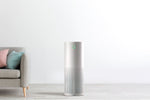Activated Carbon Filters are highly porous, high surface area substrates good at capturing odor-causing molecules. They help with volatile organic compounds (VOCs) – molecular sized gases from the built environment and cleaning and disinfecting chemicals used on surfaces and instruments. Those chemicals are important for sanitizing surfaces, but they don’t belong in the air we breathe. While that disinfectant-”clean” smell may indicate clean surfaces, it also means that there are volatile organic molecules in the air. The more open and available pores are present in a carbon filter – the more “activated” it is, and the better it is at trapping gaseous pollutants. Granulated carbon filters will be more affected (have more surface area) and will be longer lasting than any spray-on or carbon coated type of filter. The amount of material and porosity will determine how well your carbon filter works and how long it lasts before being deactivated and needing replacement.
Ozone Generators, as the name implies, produce O3, a molecule that is very reactive and thus able to neutralize odors, kill mold, and react with different air pollutants to change their composition. This is because ozone is a higher energy free radical, the kind of molecules for which we take anti-oxidants like Vitamin C. US EPA reports explain that ozone can also cause health problems at high concentrations. In fact, studies from the US EPA show that low levels of ozone do not effectively destroy indoor air pollutants. Ozone is a well-documented lung irritant. The use of on-purpose ozone generators in any space is strongly opposed.
Electrostatic Air Purifiers charge particles in the air so they can stick to oppositely charged plates inside the device. These devices can also produce high amounts of ozone as a byproduct
Ultraviolet Germicidal Irradiation (UVGI) involves the use of specific wavelength UV-C lamps employed to damage the structure of fungal spores, viruses, and bacteria. The US EPA notes several studies in an extensive report on residential air cleaner technologies (jump to page 26) that demonstrate the potential usefulness of high energy UV-C irradiation for partial reduction of some microorganisms on internal surfaces of air cleaners but that action against airborne microbial targets is insufficient given the typical exposure times, sustained intensity, penetration ability of the light, and even resistance by some organisms. To be effective against the targets that are susceptible to UV-C, the exposure needs to be significantly longer than the few seconds seen in most air purifiers. Finally, UVGI would not be used independently of a HEPA filter so what additional benefit it brings is questionable.
Photocatalytic Oxidation (PCO/PECO) uses UV light and a photocatalyst to oxidize gasses and capturecaptured particles into CO2 and other benign gasses. Depending on the molecules, some PCO/PECO have been shown to generate formaldehyde, acetaldehyde, carbon monoxide, and nitrogen dioxide. While these technologies potentially serve to clean the inside of the PCO surfaces, HEPA filters are still required to capture airborne particulates. Most of the out-sized claims from devices with this technology have been retracted.




